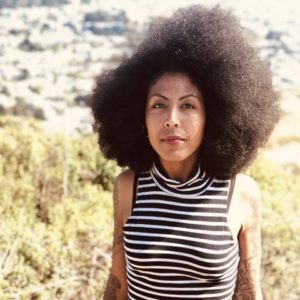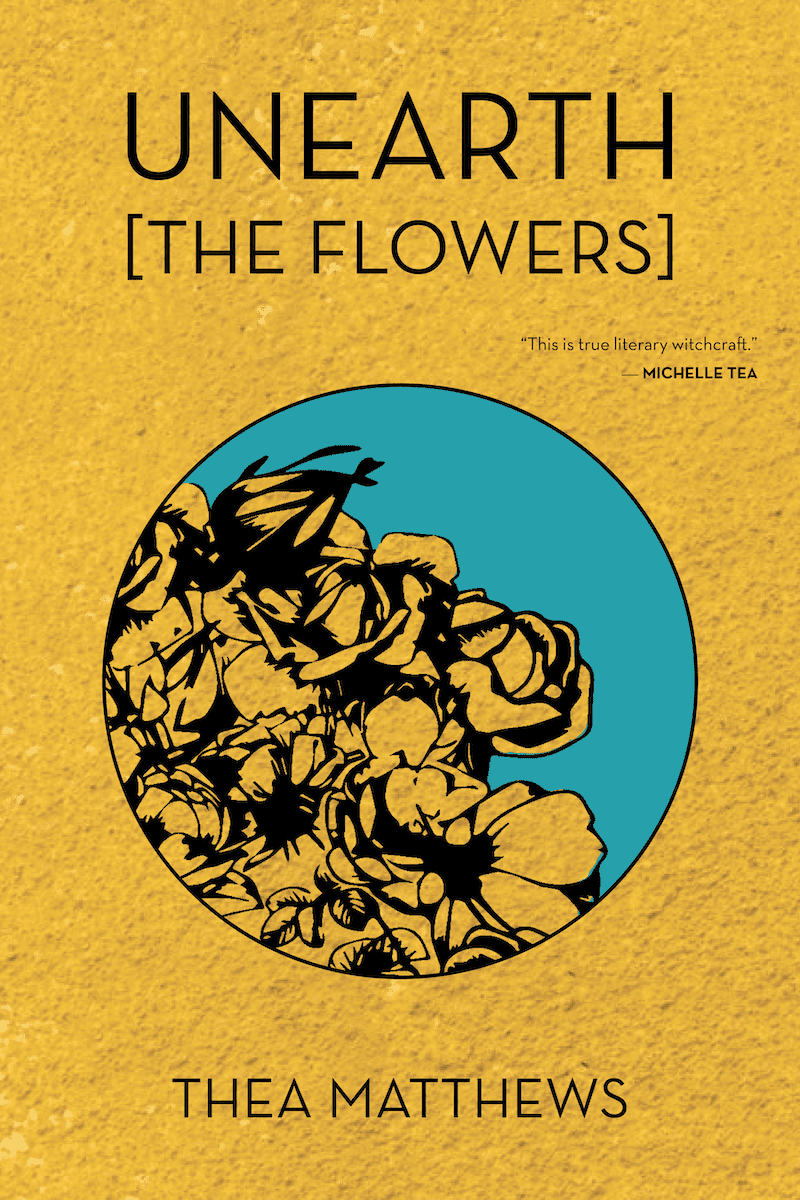
The Rumpus Poetry Book Club chats with The Matthews about her new collection Unearth [The Flowers], finding inspiration in flowers, triumph over trauma, the brilliant bluntness of June Jordan, and more.
This is an edited transcript of the book club discussion. Every month the Rumpus Poetry Book Club hosts an online discussion with the book club members and the author, and we post an edited version online as an interview. To join the Rumpus Poetry Book Club, click here. Upcoming poets include Benjamin Garcia, Sumita Chakraborty, Vijay Seshadri, Molly Spencer, Kimberly Grey, torrin a. greathouse, Erin Belieu, and more!
This Rumpus Poetry Book Club interview was edited by Brian Spears.
***
Brian S: So, let’s talk about your book some. I really enjoyed the choice to use flowers as the controlling metaphor in the book, especially the division between perennials and annuals. Can you talk some about what went into that choice? Did you write the poems with that in mind, or did they seem to fall naturally into those divisions?
Thea Matthews: Thank you. For Unearth [The Flowers], I wrote the poems primarily with the flower already in mind. And, it was after I had the poems that the sections of perennials and annuals emerged for the collection’s order.
I interwove the language and symbolism of flowers with autobiographical content based on a combination of inspiration and research of flower essences and of botany, as well as the geography of a particular flower.
Brian S: Are some of the included flowers kinds you had more experience with personally? I felt like there were some poems where the flower imagery seemed to pull on experience a bit more than others.
Thea Matthews: Yes, some of the flowers I had more personal experience with. For instance, “Marigold” is a flower used for Day of the Dead/Día de Muertos celebrations and rituals rooted in Mexican culture. In addition to being Black, I am Mexican, and in writing personifying “Marigold” I was able to illustrate further how the flower is used as light for the dead when they return to their altars that families decorate annually. Within this poem, I also highlight personal familial dynamics and the resiliency of life through spiritual death. “Seaside Daisy” is another poem where this flower is often seen by Ocean Beach and coastal regions, as a poem for a lost loved one who loved the ocean.
Each poem cultivates a unique relationship with the flower and each flower is acknowledged either through its meaning of flower essences, its physical aesthetics, and/or its historical symbolism…
Brian S: One of the things I appreciated about these poems was the way you often made the flowers the speakers of the poems. Like in “Morning Glory,” for instance, because it lets the speaker be witness to things that are going on without making it so the authorial voice intrudes quite as much. Like, there’s the speaker and a separate “she” that the speaker describes.
Thea Matthews: Yes! Omg, can you tell like I personification! lol
Brian S: There’s a sense of mourning in that poem, and it takes the reader a moment to decide if the speaker is the Morning Glory or if it’s the person being described.
Yes, and it sometimes feels like you’re venturing into persona as well
Thea Matthews: Yes, and yes! Through utilizing such literary devices, I was able to hone in on the “splitting” that can often occur when one is afflicted with C-PTSD. The vacillation between personification and persona also allowed me to acknowledge healing modalities that incorporate the interaction between multiple parts of self, as well as inner-child work. With “Morning Glory“ definitely is a poem that fits within this category. “She is within me…” I do the same in “Lilac,“ as well. And “Chrysanthemum.“
Brian S: That’s a common theme in these poems, that sense of trying to heal from past trauma.
Thea Matthews: Yes, this first book is a triumph over trauma collection, illustrating the alchemy of healing.
Brian S: I feel like I read echoes of June Jordan in this book
Thea Matthews: O yes! As an undergrad at UC Berkeley, I took June Jordan’s program Poetry for the People (P4P) led by Aya de Leon. Aya carries June’s legacy in her curriculum, and the first poems I wrote for Unearth [The Flowers] were when I was in P4P.
This first collection is Black feminist, proclaiming the personal is political, and in many ways it serves as a reclamation of power and of the female body. I love June’s work, and she is forever a foremother of mine. What she has taught me is not so much the content, because my newer work is much more political and speaks to the systemic injustices that pervade society, but it was how… to build intimacy with the reader, to orient them and with an active tone, deliver whatever needs to be delivered.
Brian S: I remember the first time I ever taught a June Jordan poem to some undergrads. It was “Poem about My Rights,” and they kind of sat there, stunned, afterward. Like they’d never heard a poet be so blunt about the world.
Thea Matthews: YES! Omg is she blunt. Gotta be.
Brian S: They were used to having to tease out meaning, like it was a puzzle. That’s what they’d been taught in high school. It was also a learning experience for them because they didn’t know how things like rape laws had changed, so it was an eye-opener. I guess what I’m saying is you could do a lot worse for influences than June Jordan.
Which of these poems do you tend to read/perform the most publicly?
Thea Matthews: Yes, to poetry being like a puzzle… I love June’s work because her tone glares the reader, and her style is so raw. She is not one to utilize ambiguity as a literary device. Nope, she’s like HERE! You see this, read this, this is what is going on. Truth.
In the beginning, I would read whatever batch of poems I had.. I would deliver poems still in earlier stages. “Lilac“ has been the poem where I would see audience members cry. And that, to me, was a confirmation I was onto something… that these words have impact, these words are ushering breakthroughs for folks to feel.
Now, I read whatever I find fitting to the event.
Brian S: So you’re kind of still working out a set list?
Thea Matthews: O no. I have a set list now; in the beginning I had what I had. Now, my go-tos are: “Angels Trumpet,“ “Gardenia,“ “Chamomile,“ “Rain Lily,“ “Gazania,“ “Azalea,“ “Fucshia,“ and “The Prelude.“
Brian S: This feels like a weird question but I’ve been asking everyone about it the last few months. How has the pandemic affected the way you see your book in the world, especially trying to launch it and promote it?
Thea Matthews: Perfectly fitting. COVID-19 has revolutionized my publisher’s approach, as well as my approach, in how to reach more people. The pandemic has prompted me to rely on virtual means to reach the people and to build ties with independent bookstores. Podcasts, social media, and book clubs have been really good to us. Also, humans know how to adapt after shock. Now, there are more and more virtual literary arts events being held; the silver lining is that since it is virtual, people living in multiple time zones can attend one event. Definitely, this is not how I would have foreseen the landscape, but I’ll take it. I am very grateful for electricity and the internet.
Brian S: I’m glad we were able to be a part of it. Thanks for joining us tonight.
Thea Matthews: O yes, I am super grateful for the Rumpus! Thank you for featuring Unearth [The Flowers] in your Poetry Book Club. Thank you for having me. 🙂
Brian S: Have a great rest of your night!
Thea Matthews: Thanks Brian. You, too! May you and your loved ones stay safe.
***
Photograph of Thea Matthews by Jennifer Lewis.






